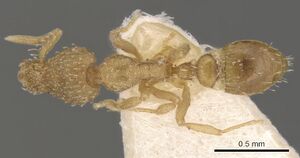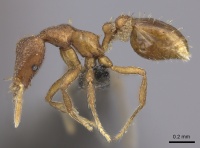Strumigenys truncatidens
| Strumigenys truncatidens | |
|---|---|

| |
| Scientific classification | |
| Kingdom: | Animalia |
| Phylum: | Arthropoda |
| Class: | Insecta |
| Order: | Hymenoptera |
| Family: | Formicidae |
| Subfamily: | Myrmicinae |
| Tribe: | Attini |
| Genus: | Strumigenys |
| Species: | S. truncatidens |
| Binomial name | |
| Strumigenys truncatidens (Brown, 1950) | |
| Synonyms | |
| |
Known from litter-samples taken in a number of wet forest habitats.
Identification
Bolton (2000) - A member of the truncatidens complex in the Strumigenys emarginata group. Characters of truncatidens-complex. In full-face view dorsolateral margin of head behind level of apex of scrobe with 4-6 laterally projecting hairs that curve anterodorsally. Mesonotum with 1-3 pairs (usually 2) of standing hairs. Dorsum of pronotum sculptured; mesonotum, propodeum (including upper half of declivity) and petiole node reticulate-punctate.
Disc of postpetiole usually smooth but in some populations weakly sculptured to costulate. Maximum diameter of eye 0.14-0.16 X HW.
The discovery of more material has allowed the synonymy of truncatidens and dendexa. Initially the two were separated as specimens ascribed to the former had a reticulate-punctate pronotal dorsum, whereas those ascribed to the latter had fine longitudinally rugulae on this sclerite. In material now available some have the pronotum reticulate-punctate; in others the lateral margins of the punctures are aligned and appear as weak longitudinal rugulae; in some the aligned margins are thickened and more obviously rugular in appearance. This variation in sculpture therefore has no significance at species-rank.
Bolton (1983) - S. truncatidens is closely related to Strumigenys datissa, Strumigenys gatuda and Strumigenys hensekta. Characters separating truncatidens from the last of these are tabulared under hensekta. S. datissa is a more darkly coloured species which lacks the freely projecting hairs on the sides of the head which are seen in truncatidens. It also lacks standing hairs on the dorsal alitrunk and has the postpetiolar disc strongly costulate. In gatuda the alitrunk and petiole dorsum are glassy smooth with widely scattered punctures and the sides of the alitrunk are unsculptured except for the central mesopleuron. The eyes are distinctly smaller, measuring only 0.09 x HW in gatuda as opposed to 0.14-0.16 X HW in truncatidens. Finally dendexa, a smaller species, is separated by its possession of fine longitudinal rugulose sculpture on the pronotum, which is not present in truncatidens.
Keys including this Species
Distribution
Latitudinal Distribution Pattern
Latitudinal Range: -3.7452° to -3.96667°.
| North Temperate |
North Subtropical |
Tropical | South Subtropical |
South Temperate |
- Source: AntMaps
Distribution based on Regional Taxon Lists
Afrotropical Region: Burundi, Cameroun, Equatorial Guinea, Ivory Coast, Kenya, Rwanda, Uganda, United Republic of Tanzania.
Distribution based on AntMaps
Distribution based on AntWeb specimens
Check data from AntWeb
Countries Occupied
| Number of countries occupied by this species based on AntWiki Regional Taxon Lists. In general, fewer countries occupied indicates a narrower range, while more countries indicates a more widespread species. |

|
Estimated Abundance
| Relative abundance based on number of AntMaps records per species (this species within the purple bar). Fewer records (to the left) indicates a less abundant/encountered species while more records (to the right) indicates more abundant/encountered species. |

|
Biology
Life History Traits
- Mean colony size: 133 (Dejean, 1982; Beckers et al., 1989)
- Foraging behaviour: solitary forager (Dejean, 1982; Beckers et al., 1989)
Castes
Images from AntWeb
   
| |
| Paratype of Smithistruma dendexa. Worker. Specimen code casent0900070. Photographer Will Ericson, uploaded by California Academy of Sciences. | Owned by NHMUK, London, UK. |
Nomenclature
The following information is derived from Barry Bolton's Online Catalogue of the Ants of the World.
- truncatidens. Smithistruma (Smithistruma) truncatidens Brown, 1950b: 43, pl. 3, fig. 1 (w.) TANZANIA. Combination in Pyramica: Bolton, 1999: 1673; in Strumigenys: Baroni Urbani & De Andrade, 2007: 130. Senior synonym of dendexa: Bolton, 2000: 306. See also: Brown, 1953g: 127; Bolton, 1983: 296; Bolton, 2000: 307.
- dendexa. Smithistruma dendexa Bolton, 1983: 290 (w.) CAMEROUN. Combination in Pyramica: Bolton, 1999: 1673. Junior synonym of truncatidens: Bolton, 2000: 306.
Unless otherwise noted the text for the remainder of this section is reported from the publication that includes the original description.
Description
Worker
TL 2.4-3.0, HL 0.62-0.72, HW 0.46-0.54, CI 72-76, ML 0.10-0.12, MI 14-18, SL 0.28-0.34, SI 58-65, PW 0.30-0.35, AL 0.64-0.78 (12 measured).
Basal lamella of mandible a high rectangle, truncated apically and with shallowly concave sides. The lamella is followed without a diastema by 5 relatively large teeth, two slightly smaller teeth, a row of 4 minutes denticles and a small apical tooth. Anterior margin of clypeus concave and equipped with a series of 8 scale-like hairs, arranged in 4 pairs, which are curved towards the midline and project out over the mandibles. Lateral margins of clypeus with a continuous row of anteriorly curved spatulate to spoon-shaped large hairs which form a fringe around the clypeus. Clypeal dorsum and cephalic dorsum with numerous small flattened hairs which are curved anteriorly and appear scale-like in full-face view. The posteriormost one or two rows of hairs, close to the occipital margin, are longer, narrower and more erect. Sides of head with freely projecting elongate feebly clavate hairs which curve upwards and often weakly forwards from their points of origin. Antennal scapes bent at the basal third, broadest at or just distal to the bend. Leading edge of scape quite evenly rounded at the bend and with a series of freely projecting long stout hairs. Dorsum of head densely punctate and matt, usually with a coarsely granular appearance but sometimes with the punctures more widely spaced. Clypeal dorsum much less strongly sculptured, frequently shining. Maximum diameter of eye 0.14-0.16 X HW. Pronotum not sharply marginate laterally, the dorsum lacking a median longitudinal ridge or carina. With the alitrunk in profile the anterior half of the mesonotum elevated and on the same level as the pronotal dorsum. Posterior half of mesonotum and the propodeum markedly depressed below this level. Metanotal groove absent, the posterior half of the mesonotum and the propodeal dorsum forming a single uninterrupted surface. Propodeal teeth triangular and acute, weakly elevated and with a narrow infradental lamella. Dorsal alitrunk with a number of appressed short hairs which are most easily seen on the pronotum. Erect hairs on alitrunk restricted to a single long stout pair which are weakly clavate apically, situated on the raised anterior portion of the mesonotum. In some samples a shorter second pair of erect hairs is present further back on the mesonotum. Flagellate hairs absent. Dorsal surfaces of petiole, postpetiole and first gastral tergite with numerous suberect to erect stout hairs which are simple or feebly clavate. Sides of alitrunk punctate but the upper and posterior portions of the mesopleuron, the metapleuron and the anteriormost part of the propodeal side forming an extensive smooth area on which punctures are extremely sparse or absent. Dorsum of pronotum punctate, usually densely so but may be more widely scattered in some. Frequently the walls of the individual punctures align to form feeble rugulae and the surface appears granular. Remainder of dorsal alitrunk more sharply reticulate-punctate, the punctures extending onto the propodeal declivity between the teeth. Petiole node punctate dorsally. Disc of postpetiole commonly unsculptured but in many showing faint longitudinal costulae towards the sides. In some, often larger individuals, the costulae are more extensive and occur over most or all of the postpetiolar dorsum. First gastral tergite unsculptured except for the conspicuous basal costulae. Spongiform appendages of pedicel segments strongly developed in profile. In dorsal view the petiole node with a transverse spongiform strip on the posterior margin and the postpetiole with a narrow strip which is broadest posterolaterally but which becomes narrower medially and is vestigial or interrupted at the centre of the margin. At this point the posterior face of the postpetiole disc is itself indented. Base of first gastral tergite with a transverse lamellar strip which is not spongiform and which is traversed by the basigastral costulae, the latter arising at the anterior margin of the sclerite. Colour dull yellow to light yellowish brown.
Type Material
Holotype and paratype workers, TANZANIA: Lupembe (K. Bock) (paratype in Museum of Comparative Zoology) [examined].
References
- Baroni Urbani, C. & De Andrade, M.L. 2007. The ant tribe Dacetini: limits and constituent genera, with descriptions of new species. Annali del Museo Civico di Storia Naturale “G. Doria” 99: 1-191.
- Beckers R., Goss, S., Deneubourg, J.L., Pasteels, J.M. 1989. Colony size, communication and ant foraging Strategy. Psyche 96: 239-256 (doi:10.1155/1989/94279).
- Bolton, B. 1983. The Afrotropical dacetine ants (Formicidae). Bulletin of the British Museum (Natural History). Entomology. 46:267-416. (page 296, redescription of worker)
- Bolton, B. 1999. Ant genera of the tribe Dacetonini (Hymenoptera: Formicidae). J. Nat. Hist. 3 33: 1639-1689 (page 1673, combination in Pyramica)
- Bolton, B. 2000. The ant tribe Dacetini. Memoirs of the American Entomological Institute. 65:1-1028. (page 306, fig. 205 redescription of worker)
- Brown, W. L., Jr. 1950d. Preliminary descriptions of seven new species of the dacetine ant genus Smithistruma Brown. Trans. Am. Entomol. Soc. 76:37-45. (page 43, pl.3, fig. 1 worker described)
- Brown, W. L., Jr. 1953g. Revisionary studies in the ant tribe Dacetini. Am. Midl. Nat. 50: 1-137 (page 127, redescription of worker)
- Nsengimana, V., Hagenimana, T., Barakagwira, J., de Dieu Nsenganeza, J., Iradukunda, S. C., Majyambere, M., Kizungu, O. B., Nkundimana, A., Umutoni, D., Fabrice, R., Cyubahiro, B., Kouakou, L. M., Kolo, Y., Anale, J. S., Gómez, K., Dekoninck, W. 2023. Checklist of ant (Hymenoptera: Formicidae) species from Nyungwe Tropical Rain Forest, south-western Rwanda. Journal of East African Natural History 111(2), 69-81 (doi:10.2982/028.111.0203).
References based on Global Ant Biodiversity Informatics
- Bolton B. 1983. The Afrotropical dacetine ants (Formicidae). Bulletin of the British Museum (Natural History). Entomology 46: 267-416.
- Bolton, B. 2000. The Ant Tribe Dacetini. Memoirs of the American Entomological Institute 65
- Brown W. L., Jr. 1953. Revisionary studies in the ant tribe Dacetini. Am. Midl. Nat. 50: 1-137.
- CSIRO Collection
- Garcia F.H., Wiesel E. and Fischer G. 2013.The Ants of Kenya (Hymenoptera: Formicidae)Faunal Overview, First Species Checklist, Bibliography, Accounts for All Genera, and Discussion on Taxonomy and Zoogeography. Journal of East African Natural History, 101(2): 127-222
- IZIKO South Africa Museum Collection

